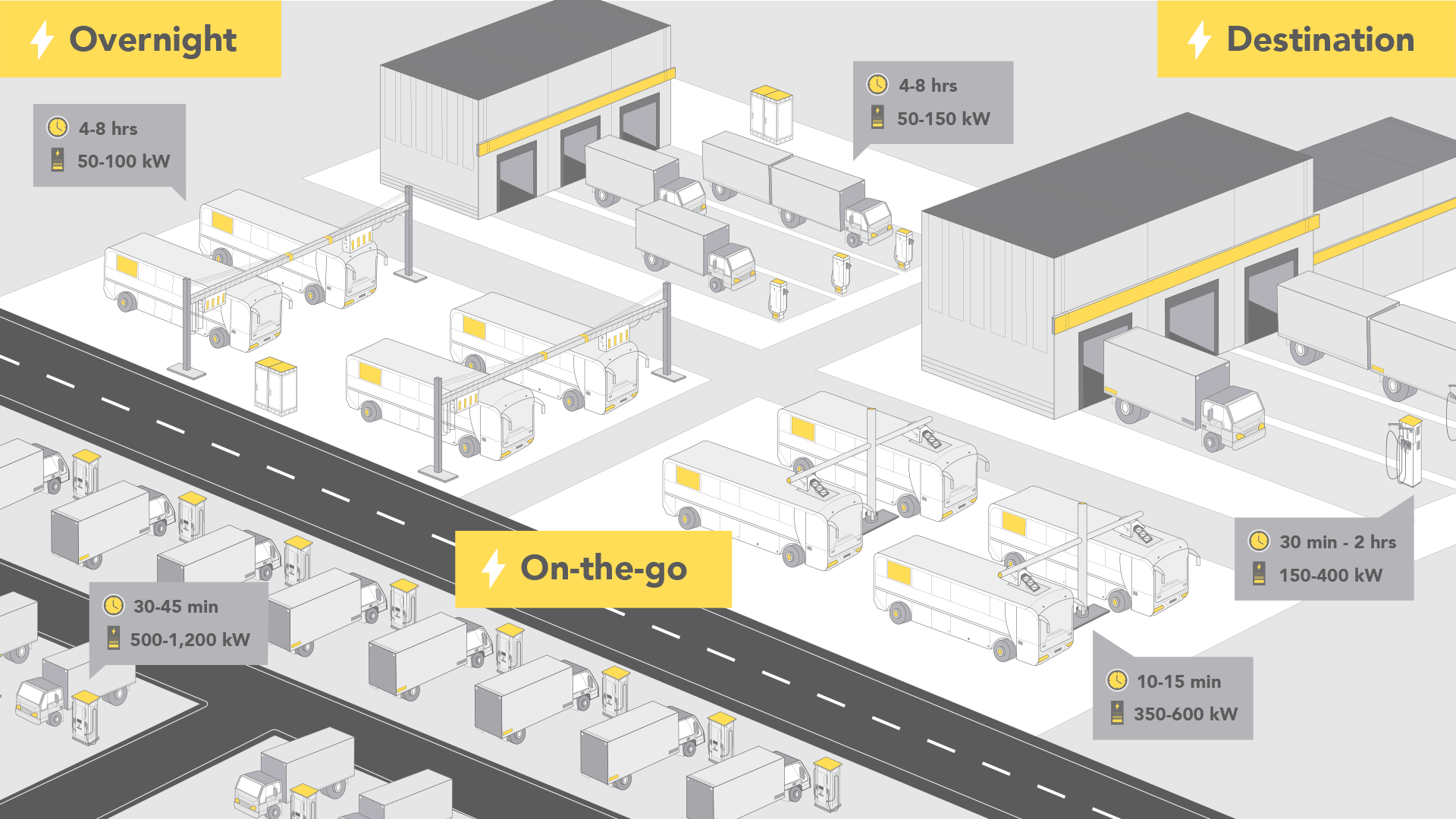As the world shifts gears towards a more sustainable future, the electrification of heavy-duty vehicles is steering us up a path of innovation and efficiency. Among the various vehicles undergoing this transformation, electric buses and trucks stand out as pivotal players in reducing emissions and enhancing urban mobility. However, ensuring they remain powered throughout their journeys requires strategic charging approaches tailored to the unique operational demands for each fleet operator.
In this blog, we delve into distinct charging strategies; overnight charging, destination charging, and on-the-go charging, each catering to the specific needs of electric bus and truck fleets.

Overnight Charging
The most prevalent charging strategy for electric buses and trucks is overnight charging. Typically conducted at depots during off-peak hours, this capitalizes on lower DC power, making it a cost-effective solution for fleet operators. With vehicles parked for extended periods— typically between 4 to 8 hours or even overnight— slow DC charging proves highly efficient.
This means that 50 to 100 kW of charging power is typically required for electric buses, while trucks require slightly higher rates, which are in the range of 50 kW to 150 kW. This strategy ensures vehicles start their daily routes fully charged, ready to navigate city streets or transport goods with minimal interruptions
Destination Charging
For electric trucks where the driving range is not sufficient to cover the daily mileage, destination charging emerges as a crucial strategy. Taking place during loading or unloading activities, typically lasting between 30 minutes to 2 hours, this approach ensures that trucks remain powered throughout their operational cycles.
Destination charging is essential for warehouses, distribution centers, and logistics hubs as it demands higher outputs ranging from 150 to 400 kW. This enables trucks to replenish their batteries swiftly, minimizing downtime and maximizing productivity on their daily route.
When vehicles are charged at third-party destinations, it's essential to implement comprehensive billing systems that enable precise tracking of charging sessions, facilitate seamless financial transactions, and provide transparent invoicing for all parties involved.
On-the-Go Charging
In scenarios where the daily mileage exceeds the vehicle's range, on-the-go charging becomes indispensable. Whether at the end of a bus route or along designated truck corridors, this strategy ensures continuous operation without compromising schedules.
Buses and trucks alike benefit from on-the-go charging. With buses requiring charging power between 350 to 600 kW and charging sessions typically lasting just several minutes, minimal disruption to their schedules and passenger services is ensured.
Trucks needing even higher rates, ranging from 500 to 1200 kW, to accommodate their larger battery capacities and heavier loads. It is recommended that drivers strategically use their mandatory 45-minute break to recharge. This ensures that they can replenish their batteries efficiently, enabling seamless journeys with minimal downtime, optimizing both operational efficiency and compliance with driving regulations.
Tailored charging approaches are shaping the path ahead
While the electrification of buses and trucks presents an array of charging strategies, it's essential to recognize the diverse needs and constraints of each approach. Depot charging stands out as the cornerstone, offering an effective solution in terms of grid constraints and cost-effectiveness. Emphasizing the significance of slower DC charging, it underscores that high-speed and high-power charging aren't the sole determinants of efficiency. Destination charging and on-the-go solutions cater to specific operational needs, ensuring seamless mobility and reducing dependance on fossil fuels.
As technology advances and infrastructure continues to evolve, defining and optimizing the tailored charging approach for each fleet will play a pivotal role in accelerating the adoption of electric transportation, driving us towards a cleaner, greener future on the roads. At the forefront of the eMobility revolution, Heliox remains a pioneer in the development of heavy-duty charging solutions. By understanding the different ways to charge heavy-duty vehicles, our flexible products are well-equipped to support the diverse charging strategies shaping the future of transportation



.png)
